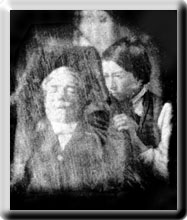![]()
Margaret
Allen
Larson
Inger
Marie
Larson
Elias
Tastad
Larson
Martha
Jane
Larson
Clara
Elizabeth
Larson
George
Monroe
Larson
Georgiana
Henrietta
Larson
![]()
Martha
Georgiana
Jorgensdatter
Eide
![]() Unknown
Unknown

Lars Larson (after death) with his son Elias Larson
Lars Larson Jeilane
Born: Abt. September 24, 1787 at Stavanger, Norway
Married: December 25, 1824 to Martha Georgiana Jorgensdatter Eide at Stavanger, Norway
Died: November 13, 1845 at Albany, New York
From "The Sloopers, Their Ancestry & Their Posterity," by J. Hart Rosdail, 1961.
LARS LARSON JEILANE was baptized Sep 24, 1787 near Stavanger, Norway. He was Capt of a packet boat in Norway which was seized by the English in the early 1800's. The ship and crew were impounded and held captive for some time. During their confinement in prison, the crew was visited on numerous occasions by English Quakers who sought to bring the men religious strength and encouragement during their inprisonment. At the time of their release, the majority of the crew of the packet ship had been converted to the Quaker belief, which they expounded upon their return to their native Norway. The state church of Norway was the Lutheran Church, and the Quakers were persecuted and ridiculed for their Quaker beliefs. Children were forceably taken from their Quaker parents to be baptised in the Lutheran Church, and dead persons were exhumed from their graves to receive the rites of the Lutheran Church.
Little mention of America was made in Norway in the early 1800's, but Lars Larson gathered his Quaker sympathizers together and presented the idea of their fleeing to America. Lars Larson held the first Quaker meeting in Norway in his home. He became the leader of the Sloopers--so called because of their ship--a sloop--on which they came to America. The tiny sloop was built in Hardanger, Norway in 1801. It was 54' long, 16' broad, and drew 7 1/2' of water. They ship was called "The Restoration". This tiny ship and its 52 people aboard sailed for America in on July 4, 1825.
Upon their arrival in the New York port on October 12, 1825, after 98 days at sea, the ship was seized by authorities because the "Sloopers" had violated a New York Port ruling. According to the law, a ship the size of "The Restoration" should have carried only 16 passengers. Since the Norwegians were planning to sell their sloop for funds, this situation put them in dire financial trouble. Through loans of funds by Quakers, the passengers from the sloop managed to secure passage to Rochester, NY via the Hudson River and the newly dug Erie Canal. The ship carrying the "Sloopers" along the canal to Rochester was enroute during the opening celebrations for the Erie Canal, and passed the packet boat carrying Governor DeWitt Clinton with his bucket of Erie Lake water to be dumped into the Atlantic Ocean upon arrival in NYC.
Lars Larson and the ship's captain stayed behind in New York City awaiting final word on their appeal to obtain their sloop from impoundment. Finally a pardon was issued by President John Quincy Adams, and the sloop was released to the owners. However, it sold for only $400, about 1/10th of what the Sloopers expected it to bring. Lars Larson set out for Rochester to join the rest of the party; however, upon reaching Albany and the Erie Canal, the water was frozen by November in the shallow canal. So Lars Larson purchased a pair of skates and skated the 290 miles to the site of the new Norwegian settlement in Kendall, west of Rochester.
For many years, the home of Lars Larson was the most important immigrant station for Norwegians in America. Nearly all of the 2900+ immigrants heading westward to Fox River, IL stayed a night at the Larson's home in Rochester. Lars Larson enjoyed a prosperous livelihood as a boat builder in the heyday of the Erie Canal. His boatyard is marked on early maps of the City of Rochester, and he built a lovely home in the affluent "ruffled shirt district" known as Corn Hill on the outskirts of flourishing Rochester, NY.
Lars Larson met an untimely death just south of Schenectady when, it is alleged, an unsavory character named Hotaling, to whom he had sold a boat loaded with furs, pushed him off a narrow walkway across a lock. Martha Larson continued for many years to offer hospitality and stability to her Quaker friends and young family.
{Note: Norwegians use a patronymic naming system where the offspring's last name is a derivitive of their father's first name--with -son added, in the case of a male child, or -datter in the case of a female. Where three names are used, very often the latter name is the name of the farm where that person resided. When a family moved, their third name changed also, reflecting the name of the new farm.
In the case of Lars Larson Jeilane, Jeilane was a farm on KANNIKETS (church) ground in Frue, Sogn--just outside Stavanger in southwest Norway.}
